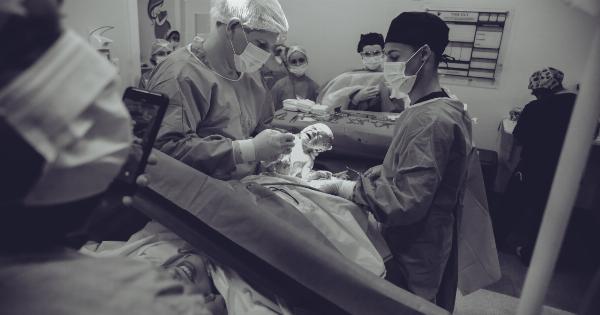Caesarean section, also known as C-section, is a surgical procedure used to deliver a baby through an incision in the mother’s abdomen and uterus.
It is often performed when vaginal delivery is not possible, or when it is safer for the mother or the baby. In this article, we will discuss the protocols followed during a Caesarean section and provide you with the essential information you need to know.
1. Indications for Caesarean Section
There are various medical indications for performing a Caesarean section. Some common reasons include:.
- Previous C-section
- Multiple pregnancies
- Fetal distress
- Placenta previa
- Malpresentation
- Maternal health conditions
2. Preoperative Assessment
Prior to the surgery, a thorough preoperative assessment is conducted to evaluate the risks and ensure the safety of the mother and baby. This assessment includes:.
- Reviewing the medical and obstetric history
- Physical examination
- Ultrasound and other diagnostic tests
- Laboratory investigations
3. Anesthesia Options
Anesthesia plays a crucial role in a Caesarean section. The two main options are:.
- Epidural anesthesia: It numbs the lower part of the body while allowing the mother to remain awake and alert.
- General anesthesia: It puts the mother to sleep during the procedure and is typically used in emergency situations.
4. Surgical Techniques
There are different surgical techniques used in a Caesarean section:.
- Classical incision: A vertical incision made in the uterus, rarely used due to increased risks
- Low transverse incision: The most common incision, which provides better healing and reduces the risk of uterine rupture during subsequent pregnancies
5. Intraoperative Considerations
During the surgery, several important considerations are taken into account:.
- Emergency situations and the need for immediate action
- Control of bleeding
- Delivery of the baby
- Assessment and management of the baby’s condition
6. Postoperative Care
Care after a Caesarean section involves both immediate recovery and long-term healing. Key aspects of postoperative care include:.
- Pain management
- Incision care and monitoring for infection
- Mobility and ambulation
- Breastfeeding support
- Emotional support for the mother
7. Potential Risks and Complications
While a Caesarean section is generally a safe procedure, it does come with potential risks and complications such as:.
- Infection
- Excessive bleeding
- Adverse reactions to anesthesia
- Wound complications
- Uterine rupture in subsequent pregnancies
8. Recovery and Healing
The recovery period after a Caesarean section varies for each woman. Some general tips for a smoother recovery include:.
- Getting plenty of rest
- Following the prescribed pain management plan
- Avoiding heavy lifting and strenuous activities
- Eating a healthy, balanced diet
- Attending postoperative check-ups
9. Vaginal Birth After Caesarean (VBAC)
In certain circumstances, a woman who has had a previous C-section may be eligible for a trial of labor for a vaginal birth after Caesarean (VBAC).
However, this decision depends on various factors and should be carefully discussed with healthcare providers.
10. Conclusion
Caesarean section protocols are designed to ensure the safety and well-being of both the mother and the baby.
While the procedure has its own set of risks and complications, it is an important and life-saving option when vaginal delivery is not possible or advisable. By understanding the protocols, potential risks, and the recovery process, expectant mothers can make informed decisions and actively participate in their childbirth experience.




























